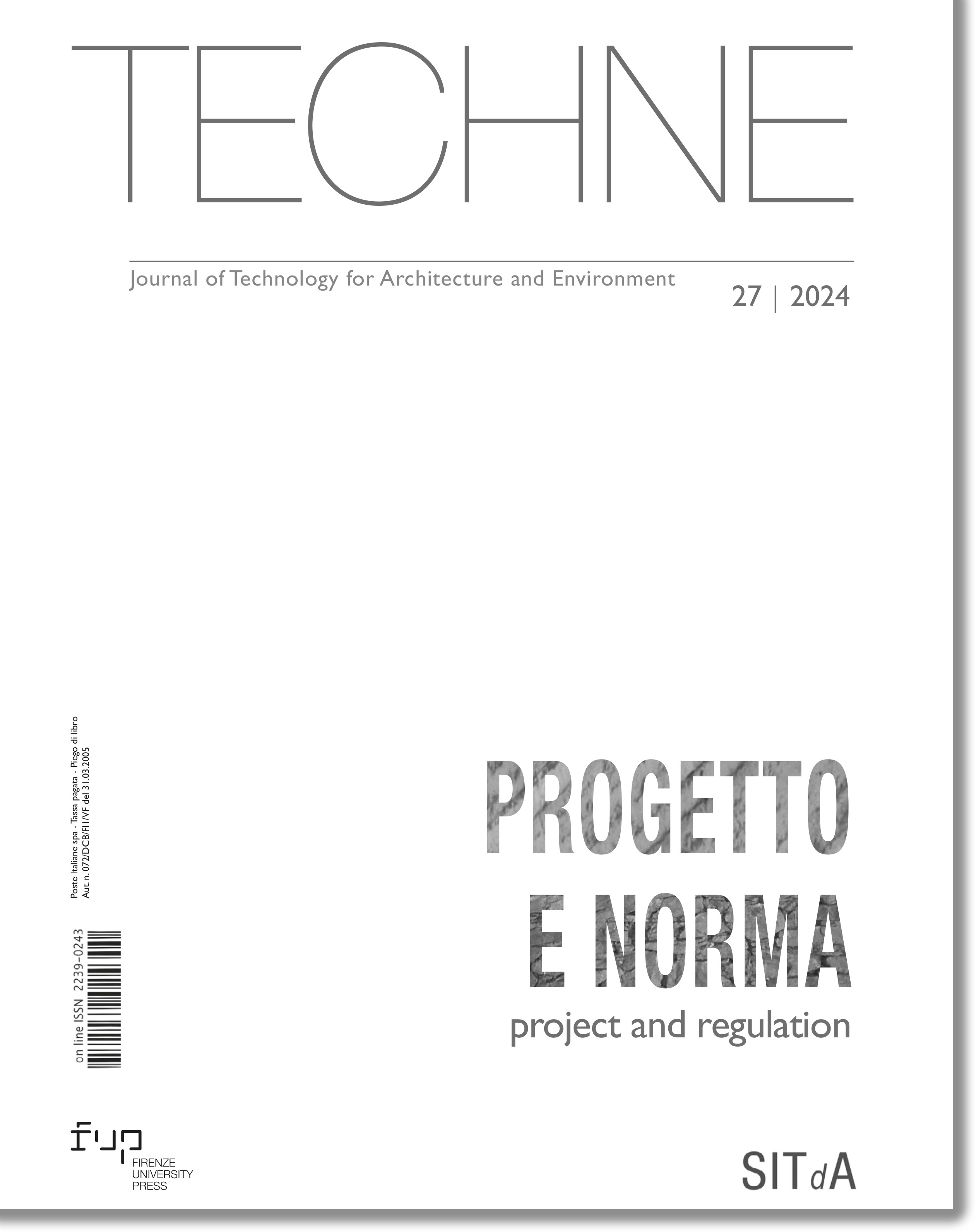Published 2024-06-10
Keywords
- Urban rules,
- Building Regulations,
- Urban morphology,
- Urban transformation,
- Turin
- Environmental Performance ...More
How to Cite
Copyright (c) 2024 Marianna Nigra, Caterina Barioglio, Daniele Campobenedetto

This work is licensed under a Creative Commons Attribution 4.0 International License.
Abstract
The objective of this paper is to explore the role of urban codes in the transformation processes of the ordinary city. By focusing on the case study of the City of Turin, the article investigates the relationship between the regulatory system and urban form through the “window” element, providing suggestions for acting on building planning and regulation tools. In particular, the object of the research is the set of rules relating to the performance of buildings with respect to the supply of daylight and its implementation with the environmental regulation system. The paper proposes an integration to the Building Regulations, with the aim of reorienting the use of rules both as control tools during the project (and not exclusively as ex post verification), and as devices capable of enabling ordinary transformations of the city.
Downloads
References
- Abramson, D.M. (2016), Obsolescence: An architectural history, University of Chicago Press, Chicago. DOI: https://doi.org/10.7208/chicago/9780226313597.001.0001
- Alfasi, N. (2018), “The coding turn in urban planning: Could it remedy the essential drawbacks of planning?”, Planning Theory, Vol. 17, n. 3, pp. 375-395. DOI: https://doi.org/10.1177/1473095217716206
- Amin, A. and Graham, S. (1997), “The ordinary city”, Transactions of the Institute of British Geographers, Vol. 22, n. 4, pp. 411-429. DOI: https://doi.org/10.1111/j.0020-2754.1997.00411.x
- Ben-Joseph, E. (2005), The Code of the City, MIT Press, Cambridge-London.
- Boschetti, B. (2017), “L’impatto della funzione di rigenerazione sugli strumenti tradizionali del diritto urbanistico diversi dalla pianificazione”, in Di Lascio F., Giglioni F. (a cura di), La rigenerazione degli spazi urbani, Il Mulino, Bologna.
- Boubekri, M. (2004), “An overview of the current state of daylight legislation”, Journal of the Human-Environment System, Vol. 7 n. 2, pp. 57-63. DOI: https://doi.org/10.1618/jhes.7.57
- Carmona, M., Marshall, S. and Stevens, Q. (2006), “Design codes: their use and potential”, Progress in Planning, Vol. 65, pp. 209-289. DOI: https://doi.org/10.1016/j.progress.2006.03.008
- Casals, X. G. (2006), “Analysis of building energy regulation and certification in Europe: Their role, limitations and differences”, Energy and Buildings, Vol. 38, pp. 381-339. DOI: https://doi.org/10.1016/j.enbuild.2005.05.004
- Habraken, N.J. (2000), The Structure of the Ordinary. For and Control in the Built Environment, MIT Press, Cambridge-London.
- IES Daylight Metrics Committee. (2012), IES Spatial Daylight Autonomy (sDA) and Annual Sunlight Exposure (ASE); Daylight Metrics Committee. Approved Method.
- IES LM-83-12. New York, NY: Illuminating Engineering Society of North America.
- Imrie, R. (2004), “The role of the building regulation in achieving housing quality”, Environment and Planning B: Planning and Design, Vol. 31, pp. 419-437. DOI: https://doi.org/10.1068/b3056
- Imrie, R. (2007). “The interrelationship between building regulations and architects’ practices”. Environment and Planning B: Planning and Design, Vol. 34, pp. 925-943. DOI: https://doi.org/10.1068/b33024
- Decreto Ministeriale Sanità (1975, Luglio 5). Modificazioni alle istruzioni ministeriali 20 giugno 1896, relativamente all’altezza minima ed ai requisiti igienico-sanitari principali locali di abitazione, Roma.
- Jalilzadehazhari, E., Johansson, J. and Mahapatra, K. (2019), “Applying a decision-making framework for resolving conflicts when selecting windows and blinds”, Architectural Engineering and Design Management, Vol 15, pp. 382-401. DOI: https://doi.org/10.1080/17452007.2018.1550383
- Kacel, S. and Lau, B. (2018), “Louis I. Khan and Richard Kelly: Collaborative design in creation of the luminous environment”, Architectural Engineering and Design Management, Vol. 14, n. 4, pp. 306-316. DOI: https://doi.org/10.1080/17452007.2017.1399857
- Kangas, H., Lazarevic, D. and Kivimaa, P. (2018), “Technical skills, disinterest and non-functional regulation: Barriers to building energy and efficiency in Finland viewed by energy service companies”, Energy Policy, Vol. 114, pp. 63-76. DOI: https://doi.org/10.1016/j.enpol.2017.11.060
- Lehnerer, A. (2009), Grand Urban Rules, Nai010 Publishers, Rotterdam.
- Marshall, S. (2011), Urban Coding and Planning, Routledge, London-New York. DOI: https://doi.org/10.4324/9780203717561
- Moroni, S. (2017), “Graphic rules in planning: A critical exploration of normative drawings starting from zoning maps and form-based codes”, Planning Theory, Vol 16, n. 3, pp. 318-338. DOI: https://doi.org/10.1177/1473095216656389
- Mardaljevic, J. (2008), Climate-based daylight analysis. CIE (Commission Internationale de l’Eclairage) Report, pp. 3-26.
- Mardaljevic, J., Andersen, M., Roy, N. and Christoffersen, J. (2011), “Daylighting metrics for residential buildings”, in Proceedings of 27th Session of CIE International Conference, Sun City, South Africa.
- Municipality of Turin (2016), Allegato Energetico Ambientale al Regolamento Edilizio della Città di Torino (Energy Code Annex to Building Regulations in Turin– in Italian). Available at: http://www.comune.torino.it/ ambiente/energia/efficienza/allegato-energetico-ambientale.s (Accessed on 18/07/2020).
- Municipality of Turin (2020), Relazione Energetico-Ambientale e conformità delle pratiche edilizie alla normativa cogente. Available at: http://www.comune.torino.it/ediliziaprivata/energia_requisiti/index.shtml (Accessed on 18/08/2020).
- Nigra, M., Lo Verso, V.R.M., Robiglio, M., Pellegrino, A., Martina, M. (2021). “‘Re-coding’ environmental regulation – a new simplified metric for daylighting verification during the window and indoor space design process”, Architectural Engineering and Design Management, Vol. 18, pp. 1-24. DOI: https://doi.org/10.1080/17452007.2021.1941738
- Society of Light and Lighting (2014), Lighting guide 10. Daylighting – a guide for designers.
- Talen, E. (2012), City Rules: How Regulations Affect Urban Form, Island Press, Washington-Covel-London, UK.






